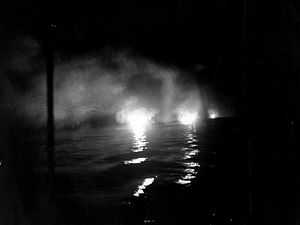Battle of Kula Gulf
| ||||||||||||||||||||||||||||||
The naval Battle of Kula Gulf (Japanese: クラ湾夜戦) took place in the early hours of 6 July 1943 during World War II and was between United States and Japanese ships off the coast of Kolombangara in the Solomon Islands.
Background
On 5 July, United States Navy Task Group 36.1 (TG 36.1)—commanded by Rear Admiral Walden L. Ainsworth and consisting of the light cruisers USS Honolulu (CL-48), USS St. Louis (CL-49), and USS Helena (CL-50), plus four destroyers, had received word of another "Tokyo Express" mission down "the Slot" in the Solomon Islands, and the task group proceeded northwest past New Georgia Island.
The Allies were in the process of launching their next offensive in the Solomon Islands, having just landed troops on the island of Rendova as a preliminary step to seizing the major Japanese airstrip at Munda on New Georgia Island. In support of this landing, which was to set up an initial beachhead for moving U.S. troops across Blanche Channel to New Georgia, Admiral Ainsworth had the night before conducted a cruiser bombardment of Vila on Kolombangara Island and Bairoko on New Georgia and, short of fuel and ammunition, was in the process of retiring to the Coral Sea to replenish. A U.S. Marine landing was scheduled on the northern shore of New Georgia on 10 July, that would require further naval support.
Battle
At 01:06 off Kolombangara, the task group came into contact with a Japanese reinforcement group commanded by Admiral Teruo Akiyama which consisted of ten destroyers loaded with 2,600 combat troops that were bound for Vila, which they used as a staging point for moving into Munda. The Japanese were divided into two forces, a formation of three escorts trailing the main column first came under attack.
The U.S. ships opened fire at 01:57, firing 612 shells in 21 minutes and six seconds, quickly sinking the destroyer Niizuki and killing Admiral Akiyama. However, Helena had expended all of her flashless powder the previous night, she was forced to use smokeless powder, thus illuminating herself to the Japanese ships with every salvo. Two of the Japanese destroyers launched their Long Lance torpedoes and hit Helena, fatally damaging her. The main Japanese force, which had countermarched away from Vila with the first contact, then broke away, having landed only 850 of the 2,600 troops. The Japanese destroyer Nagatsuki ran aground, while Hatsuyuki was damaged.
Both forces began to withdraw from the area, but one Japanese and two American destroyers remained to rescue survivors. At about 05:00, the destroyers Amagiri and USS Nicholas exchanged torpedoes and gunfire. Amagiri was hit and retired. The beached Nagatsuki was abandoned by her crew in the morning, she was bombed and destroyed by American aircraft.
Aftermath
The destroyers USS Radford and Nicholas both stayed behind to rescue survivors from Helena. While rescuing over 750 men, Radford and Nicholas had to reengage the enemy three times, they were awarded the Presidential Unit Citation for their rescue. Amagiri escaped and later rammed and cut in half the motor torpedo boat USS PT-109, captained by future President of the United States John F. Kennedy (1917-1963), in Blackett Strait southwest of Kolombangara on August 2.
Namesake
The U.S. Navy escort aircraft carrier USS Kula Gulf—in commission from 1945-1946, 1951-1955, and 1965-1969—was named for this battle.
| Wikimedia Commons has media related to Battle of Kula Gulf. |
Notes
References
- Brown, David (1990). Warship Losses of World War Two. Naval Institute Press. ISBN 1-55750-914-X.
- Crenshaw, Russell Sydnor (1998). South Pacific Destroyer: The Battle for the Solomons from Savo Island to Vella Gulf. Naval Institute Press. ISBN 1-55750-136-X.
- D'Albas, Andrieu (1965). Death of a Navy: Japanese Naval Action in World War II. Devin-Adair Pub. ISBN 0-8159-5302-X.
- Dull, Paul S. (1978). A Battle History of the Imperial Japanese Navy, 1941-1945. Naval Institute Press. ISBN 0-87021-097-1.
- Domagalski, John J. (2012). Sunk in Kula Gulf: The Final Voyage of the USS Helena and the Incredible Story of Her Survivors in World War II. Potomac Books Inc. ISBN 1597978396.
- Hara, Tameichi (1961). Japanese Destroyer Captain. New York & Toronto: Ballantine Books. ISBN 0-345-27894-1.
- Hone, Thomas C. (1981), "The Similarity of Past and Present Standoff Threats", Proceedings of the U.S. Naval Institute (Annapolis, Maryland) (Vol. 107, No. 9, September 1981): 113–116, ISSN 0041-798X
- Kilpatrick, C. W. (1987). Naval Night Battles of the Solomons. Exposition Press. ISBN 0-682-40333-4.
- McGee, William L. (2002). "Operation TOENAILS". The Solomons Campaigns, 1942-1943: From Guadalcanal to Bougainville--Pacific War Turning Point, Volume 2 (Amphibious Operations in the South Pacific in WWII). BMC Publications. ISBN 0-9701678-7-3.
- Morison, Samuel Eliot (1958). Breaking the Bismarcks Barrier, vol. 6 of History of United States Naval Operations in World War II. Castle Books. ISBN 0-7858-1307-1.
- Roscoe, Theodore (1953). United States Destroyer Operations in World War Two. Naval Institute Press. ISBN 0-87021-726-7.
External links
| Wikimedia Commons has media related to Battle of Kula Gulf. |
